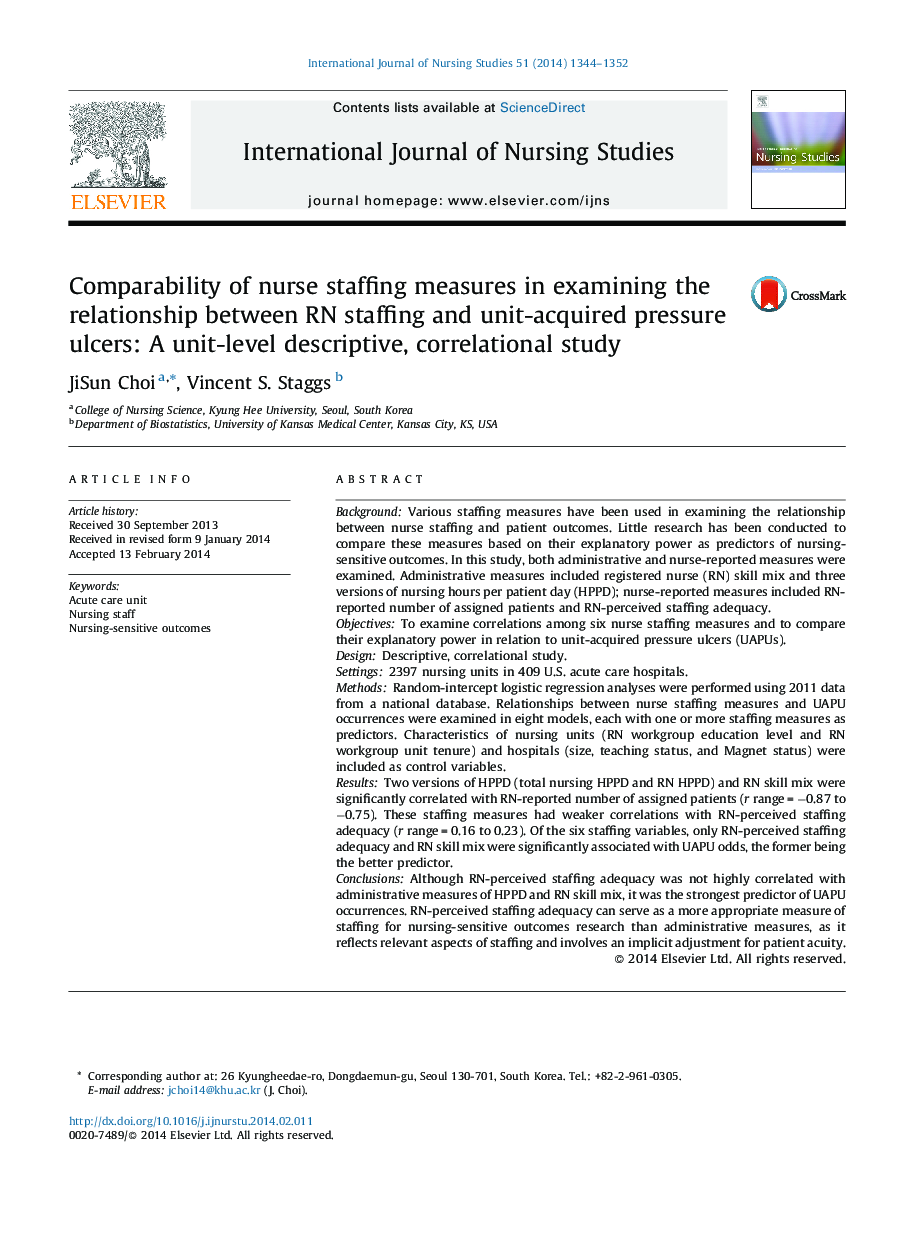| کد مقاله | کد نشریه | سال انتشار | مقاله انگلیسی | نسخه تمام متن |
|---|---|---|---|---|
| 1076140 | 1486531 | 2014 | 9 صفحه PDF | دانلود رایگان |

• Although there is a large body of evidence linking nurse staffing with patient outcomes, studies of the relationships of nurse staffing to inpatient falls and pressure ulcers have yielded inconclusive results.
• The use of different measures of nurse staffing is one of the factors resulting in discrepant results in studies of nurse staffing and patient outcomes.
• The most commonly used nurse staffing measures in staffing-outcomes research are nursing HPPD and RN skill mix.
• RN-reported number of assigned patient was highly correlated with administratively derived measures (HPPD and RN skill mix), whereas RN-perceived staffing adequacy was not.
• Among the six staffing variables (total nursing HPPD, RN HPPD, non-RN HPPD, RN skill mix, RN-reported number of assigned patients, and RN-perceived staffing adequacy), only RN skill mix and RN-perceived staffing adequacy were significant predictors of UAPU occurrences.
• RN-perceived staffing adequacy was the best predictor of UAPU occurrences.
BackgroundVarious staffing measures have been used in examining the relationship between nurse staffing and patient outcomes. Little research has been conducted to compare these measures based on their explanatory power as predictors of nursing-sensitive outcomes. In this study, both administrative and nurse-reported measures were examined. Administrative measures included registered nurse (RN) skill mix and three versions of nursing hours per patient day (HPPD); nurse-reported measures included RN-reported number of assigned patients and RN-perceived staffing adequacy.ObjectivesTo examine correlations among six nurse staffing measures and to compare their explanatory power in relation to unit-acquired pressure ulcers (UAPUs).DesignDescriptive, correlational study.Settings2397 nursing units in 409 U.S. acute care hospitals.MethodsRandom-intercept logistic regression analyses were performed using 2011 data from a national database. Relationships between nurse staffing measures and UAPU occurrences were examined in eight models, each with one or more staffing measures as predictors. Characteristics of nursing units (RN workgroup education level and RN workgroup unit tenure) and hospitals (size, teaching status, and Magnet status) were included as control variables.ResultsTwo versions of HPPD (total nursing HPPD and RN HPPD) and RN skill mix were significantly correlated with RN-reported number of assigned patients (r range = −0.87 to −0.75). These staffing measures had weaker correlations with RN-perceived staffing adequacy (r range = 0.16 to 0.23). Of the six staffing variables, only RN-perceived staffing adequacy and RN skill mix were significantly associated with UAPU odds, the former being the better predictor.ConclusionsAlthough RN-perceived staffing adequacy was not highly correlated with administrative measures of HPPD and RN skill mix, it was the strongest predictor of UAPU occurrences. RN-perceived staffing adequacy can serve as a more appropriate measure of staffing for nursing-sensitive outcomes research than administrative measures, as it reflects relevant aspects of staffing and involves an implicit adjustment for patient acuity.
Journal: International Journal of Nursing Studies - Volume 51, Issue 10, October 2014, Pages 1344–1352